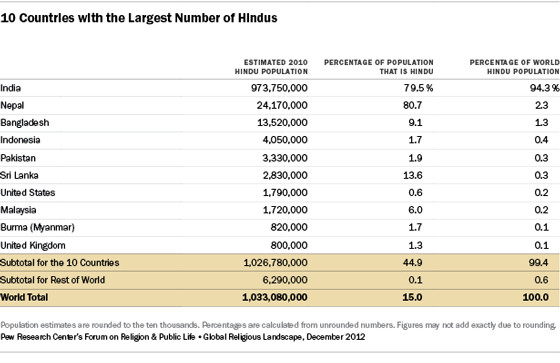Hinduism, with its roots tracing back to the Asia-Pacific region, is the faith of approximately 1 billion people worldwide, constituting about 15% of the global population. Characterized by diverse traditions such as Vaishnavism, dedicated to the god Vishnu, and Shaivism, centered on the god Shiva, Hinduism exhibits a rich tapestry of worship and beliefs. Understanding where Hinduism is practiced reveals a fascinating geographical distribution, deeply rooted in its origins yet extending across the globe.
While Hinduism boasts a global presence, it is notably the most geographically concentrated among major world religions. An overwhelming majority, exceeding 99%, of Hindus reside in the Asia-Pacific region. This region is undeniably the heartland of Hinduism, where its traditions and practices have flourished for millennia. In fact, less than 1% of the global Hindu population lives outside of Asia and the Pacific, highlighting the religion’s strong geographical center.
 A world map highlighting the concentration of Hindus in Asia, particularly India and surrounding countries
A world map highlighting the concentration of Hindus in Asia, particularly India and surrounding countries
Despite the significant Hindu population in Asia and the Pacific, Hindus constitute only about a quarter (25%) of the total population within this vast region. In the other five major geographic regions of the world, Hindus represent less than 1% of the general population, underscoring their minority status outside their primary geographical area.
Within Asia, one nation stands out as the epicenter of Hinduism: India. An overwhelming 94% of all Hindus globally live in India. This single country is home to the vast majority of the world’s Hindu population, making it the most significant location for Hinduism. Beyond India, the largest Hindu populations are found in neighboring countries, Nepal and Bangladesh. Nepal accounts for 2% of the global Hindu population, while Bangladesh is home to 1%. These figures emphasize the South Asian region’s central role in the global distribution of Hinduism.
Southern Asia, as defined by the U.N. Population Division, encompasses Afghanistan, Bangladesh, Bhutan, India, Iran, Maldives, Nepal, Pakistan, and Sri Lanka. This subregion is the geographical core of Hinduism, housing approximately 99% of the world’s Hindu population. Remarkably, an estimated 60% of Southern Asia’s total population identifies as Hindu, solidifying the region’s deep connection with the faith.
Hindus constitute a majority population in only three countries worldwide: Nepal (81%), India (80%), and Mauritius (56%). Notably, 97% of all Hindus reside in these three nations, making Hinduism the most concentrated religious group in terms of living in majority-Hindu countries. This concentration further emphasizes the focused geographical nature of Hinduism’s distribution.
 A bar chart comparing the median age of Hindus to the overall global population and other religious groups
A bar chart comparing the median age of Hindus to the overall global population and other religious groups
Median Age
The median age of Hindus globally is 26 years, which is younger than the overall global median age of 28. Analyzing median age across different regions reveals interesting demographic patterns within Hinduism. The Asia-Pacific region has the youngest Hindu population with a median age of 26, followed by Sub-Saharan Africa (30) and Latin America and the Caribbean (32). In North America, the Middle East and North Africa, and Europe, the Hindu population has a median age of 33.
Comparing the median age of Hindus to the general population within each region shows further nuances. In Sub-Saharan Africa, the Middle East and North Africa, and Latin America and the Caribbean, Hindus are older than the general population. Conversely, in Europe, North America, and Asia and the Pacific, Hindus are younger than the general population.
 An age pyramid showing the age distribution of the Hindu population compared to the general population globally
An age pyramid showing the age distribution of the Hindu population compared to the general population globally
In conclusion, where Hinduism is practiced is predominantly within the Asia-Pacific region, and most notably in India. While Hinduism has spread to other parts of the world, it remains geographically concentrated in its region of origin, with Southern Asia serving as its primary geographical and cultural center. This unique distribution pattern highlights the historical and cultural factors that have shaped the global presence of Hinduism.
